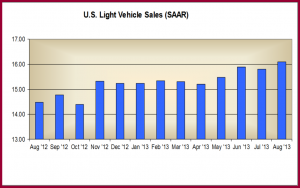
The problem at Chrysler remains the Jeep Cherokee that it has been building for several months, but has yet to ship any or reap revenue because of an emissions control certification problem.
Chrysler, Ford and GM all recorded double digit gains in U.S. August sales as the market went back to pre-Great Recession levels of 2007. Robust pickup truck sales, a relatively trouble free changeover to the production of 2014 models, cheap credit, strong retail demand, and a Labor Day weekend that fell in August were factors in an overall industry that is now running at more than 16 million units annually.
As always, August sales of Detroit Three pickup trucks led the way with the Ford F-Series – more than 71,000 sold – at the head of the list. It was the second month of the year that F-Series topped 70,000 with Ford well on the way to sell a million F-Series pickups in 2015 when a new version appears. Ford is now spending about $4,200 to $4,500 in incentives per truck sold. The average transaction price on F-Series trucks remain the highest in the industry and they’re up about $800 compared to a year ago.
Chevrolet followed with 44,000 Silverado pickups. Ram moved 33,000 pickups from the factory to dealerships. While GMC sold 18,000 Sierra pickups. Noteworthy was GM’s seamless changeover to its new pickup models, GM’s 22% increase in retail sales at 220,958 and an impressive 5% decline in fleet sales to 20% of its total. The Chevrolet Volt due to a price cut and high gasoline costs had its best month ever at 3,400, as did the Chevrolet Spark (4,500), Chevrolet Sonic (11,000), Cadillac XTS (3,500) and Buick Verano (5,800).
Ford Motor Company August retail sales increased 20%, its best retail sales month since August 2006 as total sales increased 12% to more than 221,000 vehicles. However, this good performance was overshadowed by Toyota Motor Corporation sales of 230,000 vehicles displacing Ford and keeping the Number One Japanese automaker in second place in U.S. sales for the second straight month. With new Toyota Corolla compact cars and Tundra pickup trucks just entering production, the back half of the year will see a battle royal between the two global automakers as Ford tries to increase production of its Fusion sedan at Flat Rock with a green workforce of 1,400 new hires. If all goes well, Ford should have another 100,000 Fusions to sell on an annual basis starting late this fall. (Read Offshore Brands Move Ahead in July. Toyota outsells Ford)
Chrysler Group sold 166,000 vehicles for a 12% increase with six models setting sales records in August. The Dodge Journey mid-size crossover with its 12% increase had its best sales month ever. In addition, the Dodge Challenger, Dodge Dart, Jeep Wrangler, Jeep Compass, and Jeep Patriot each recorded their best sales for the month of August.
The problem at Chrysler remains the Jeep Cherokee that it has been building for several months now, but has yet to ship any or gain any revenue because of an emissions control certification problem with the 9-speed automatic transmission. When resolved, Chrysler’s results will look even better, which parent company Fiat desperately needs give the ongoing economic disaster in Western Europe. (Read Fiat SpA Q2 Profit at $188 Million – all from Chrysler and $507 Million Chrysler Q2 Profit. New Cherokee Sales on Hold!)
Not all this is good news for automakers in general, and specifically the Detroit Three. Drastic capacity cuts during President Bush’s Great Recession have caught them out with the market recovery volume now at 16 million that is running at least one year ahead of forecasts made as recently as recently as the spring of this year. Assembly lines are not instant coffee. They take time to tool and man. Mandatory worker overtime and cancelled vacations are the rule these days, which ultimately will wear down UAW – and independent workers at Japanese companies – and inevitably lead to quality declines.

